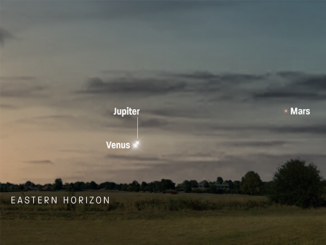
The brightest and faintest planets visible to the naked eye* appear closest in the sky at 15:36 UT on Sunday, 8 March. At this time, magnitude -4.3 Venus lies 2.2 degrees north of magnitude +5.9 Uranus against the constellation backdrop of Aries. For observers in the heart of the British Isles, the sky is dark enough to view the pair in binoculars about 25° high in the west around the onset of nautical dusk, which is about 7:30pm GMT.
If you are successful in viewing Venus and Uranus in the same binocular field of view on the evening of 8 March, consider their magnitude difference of 10.2 times, which equates to a difference in brightness (neglecting their varied apparent sizes and phases) exceeding 12,000 times!
Also bear in mind that this close conjunction of Venus and Uranus is merely a line of sight effect. Physically, Venus’ diameter of 12,100 kilometres is just 600 kilometres smaller than Earth, but Uranus is 4.2 times larger and lies 24⅔ times farther away than Venus on the UK evening of 8 March 2020.
* Under optimal conditions, most observers would say that there are five planets visible to the unaided eye — Mercury, Venus, Mars, Jupiter and Saturn, Venus being the brightest. But if we assume a naked-eye limit of magnitude +6 for a keen-sighted individual from a location devoid of moonlight and light-pollution, we can also add Uranus to the list.



